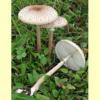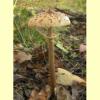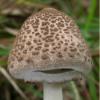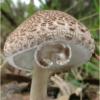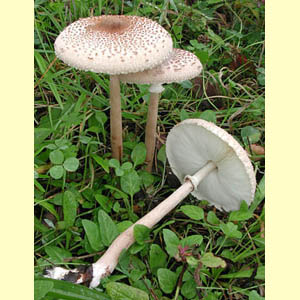
images/Macrolepiota/Macrolepiota_clelandii_KRT2843.jpg
Medium to very large agaric, growing on the ground, with a white or rarely pale pink spore print. Pileus white, pale, brown or grey, rarely black, not viscid. Lamellae remote or free. Stipe central. Partial veil remnants a membranous annulus. Spores hyaline, dextrinoid, smooth; germ pore narrow or broad. Cheilocystidia present. Lamellar trama regular. Pileipellis a trichoderm. Clamp connections absent or rarely present.
Chlorophyllum molybdites has a green spore print and
C. hortense lacks a germ pore. The other species of
Chlorophyllum are very similar macroscopically, but the pileipellis is a hymeniderm (or epithelium) of subclavate to clavate elements, whereas in
Macrolepiota it is a trichoderm of cylindrical elements. In addition, there is a hyaline cap over the germ pore in
Macrolepiota which is absent in
Chlorophyllum. Most species of
Lepiota are smaller than
Macrolepiota and all lack a germ pore. In
Leucoagaricus and
Leucocoprinus the pileus is not usually distinctly squamulose and clamp connections are always absent.
Macrolepiota Singer, Pap. Michigan Acad. Sci 32: 141 (1948).
Three species:
Macrolepiota clelandii,
M. eucharis and
M. dolichaula.
Most Australian records of the Northern Hemisphere M. excoriata, M. gracilenta, M. konradii, M. mastoidea and M. procera are likely to be M. clelandii.
W.A., S.A., Qld, N.S.W., Vic. and Tas. (and probably also N.T.).
In native forests and pine plantations, sometimes in disturbed, grassy areas, or in pastures.
On the ground.
Saprotrophic.
Aberdeen, J.E.C. (1992),
Lepiotoid Genera (Agaricales) in South-eastern Queensland. Aberdeen Publications, Gailes, Queensland. [
Description,
Microcharacters and
B&W Illustration of
M. clelandii (as
L. mastoidea) and
M. dolichaula]
Bougher, N.L. & Syme, K. (1998), Fungi of Southern Australia. University of Western Australia Press, Nedlands. [Description, Illustration and Microcharacters of M. clelandii (as M. konradii)]
Fuhrer, B. (2005), A Field Guide to Australian Fungi. Bloomings Books, Hawthorn. [Description and Illustration of M. clelandii (as clelandii and also as procera, no. 175) and M. dolichaula]
Grgurinovic, C.A. (1997a), Larger Fungi of South Australia. The Botanic Gardens of Adelaide and State Herbarium and The Flora and Fauna of South Australia Handbooks Committee, Adelaide. [Description, Illustration and Microcharacters of M. clelandii and M. dolichaula]
McCann, I.R. (2003), Australian Fungi Illustrated. Macdown Productions, Vermont. [Illustration of M. clelandii]
Pegler, D.N. (1977), A preliminary agaric flora of East Africa, Kew Bull., Addit. Ser. 6: 1–615. [Description, B&W Illustration and Microcharacters of M. dolichaula]
Vellinga, E.C. (2003a), Chlorophyllum and Macrolepiota (Agaricaceae) in Australia, Austral. Syst. Bot. 16: 361–370. [Description and Microcharacters of M. clelandii and M. eucharis and brief Description of M. dolichaula]
Young, A.M. (2005b), A Field Guide to the Fungi of Australia. University of New South Wales Press, Sydney. [Description and Illustration of M. clelandii, and Description and B&W Illustration of M. dolichaula]

